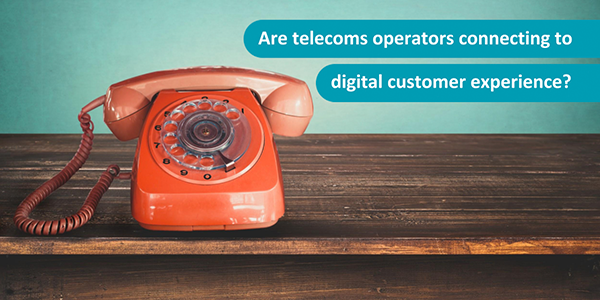Are telecoms operators connecting to digital customer experience?

Telecoms is central, even essential, to our lives. We are constantly connected and rely on communications to interact with family and friends, to work, shop, scroll, stream and generally unwind.
With multiple players ranging from mobile, broadband, landline and cable/satellite companies all offering services, telecoms is now an extremely competitive market. Indeed, it is one of the few where prices are actually dropping due to operators continually offering more in a bid to recruit and retain consumers.
Connectivity (whether that’s voice, data or a combination of both) is intangible – consumers can’t see it and only notice when services slow down or fail. This means that creating a superior customer experience and making it as easy as possible for consumers to do business with you are vital differentiators for all telecoms service providers.
Switching on better customer service
However, for years telcos have generally had a reputation for considering service as an afterthought. Now there are signs this may be changing. Vodafone, for example, has just launched a 30 day cancellation clause in contracts which means consumers and small businesses have the right to cancel without paying a penalty if they are not totally satisfied with coverage, customer service or the performance of new devices.
Moreover, consumers are now much more able than ever to make informed decisions when choosing a provider because of the regular customer surveys, service provision tests and satisfaction ratings provided by the likes of Which? and Ofcom. This heaps increasing pressure on every telco provider to up their game.
So, given the sector’s importance in our lives, how are UK telecoms operators meeting consumer’s expectations in digital customer service? Repeating research carried out for the last 6 years the Eptica Customer Conversations Study tested 10 telecoms brands on their ability to provide answers to ten routine questions via the web, as well as their speed, and accuracy when responding to email, Twitter, Facebook and chat.
Overall, telcos in the study were only able to successfully answer under half (46%) of questions asked via the web, social media and email – exactly the same as last year and well behind other sectors, such as electronics retailers (67%) and fashion (64%). On the plus side telcos did score higher than electronics manufacturers who could only answer 29% of basic queries.
Crossed wires for multichannel service
Digging deeper, one highlight was that telcos have improved hugely when it comes to providing answers via their websites. This rose by 17% compared to last year, up to 78%, the second best sector in the entire study. But even here the performance differed widely among operators with one answering 9/10 questions and another (the lowest) only managing to score 5.
By contrast, the telecoms providers performed poorly on email, with just one answering a question sent via the channel - and this only provided a partial answer. The sector performed well below the average for other verticals when it comes to email customer service and much worse than last year, showing a lack of focus on the channel.
When it comes to social media, the Twitter service level was also much worse, with a score of 30% vs 75% last year. However, Facebook did show significant improvement with a score of 90% this year, up from 60%. There were also big gaps in speed of responses received on social media ranging from 10 minutes to over 10 hours on Facebook and between 2 minutes to 1hr 2 minutes on Twitter – even though the question asked was the same on both channels.
Worryingly just one of the companies that were tested offered consumers the option to ask questions via web chat. This is hardly encouraging given how useful – and cost effective – chat can be for helping people to solve complex problems without having to pick up the phone.
So how can telecoms respond to changing consumer needs? Here are five important best practice considerations that they need to learn from:
Use automation such as self service or chatbots for more basic interactions to deliver fast answers to routine queries.
Share resources and knowledge across channels to maximise efficiency, consistency and to speed up the process of helping customers.
Empower agents with artificial intelligence and automation tools so they can free up time to use their human skills such as empathy and personalisation.
Roll out chat and resource it effectively so it is available to all consumers, when and where they need it.
Commit to continually improve by benchmarking against acknowledged CX leaders, whatever their industry.
Customer experience is a key differentiator for any sector that provides services, but telecoms companies appear to be ignoring this. While recent announcements show they are looking to improve, our data suggests the sector has some way to go before catching up with other industries and therefore meeting consumer expectations. That means that the time for telecoms providers to act is now – otherwise they face dropping behind competitors and losing customers and revenues to their rivals.






